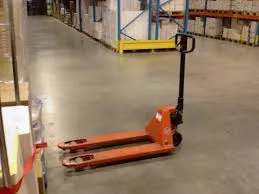


The Hydraulic Pallet Truck An Essential Tool in Modern Warehousing
In the fast-paced world of logistics and warehousing, efficiency is key. Among the various tools and equipment designed to facilitate the smooth movement of goods, the hydraulic pallet truck stands out as an indispensable ally. This versatile device simplifies the process of lifting and transporting heavy loads, making it a vital component in warehouses, distribution centers, and retail environments across the globe.
What is a Hydraulic Pallet Truck?
A hydraulic pallet truck, also known as a pallet jack, is a manual or powered device used to lift and move pallets—flat transport structures that are used to store and transport goods. Unlike forklifts, which are powered and can lift heavier loads to greater heights, hydraulic pallet trucks are generally operated manually and are suited for moving goods over short distances. The basic components of a hydraulic pallet truck include a pair of forks, a hydraulic pump, and a handle.
How Does It Work?
Hydraulic pallet trucks employ the principles of hydraulics to lift loads with minimal effort. When the operator pumps the handle, a hydraulic system directs fluid to the hydraulic cylinder, causing the forks to rise and elevate the pallet. The design allows for a significant mechanical advantage; thus, an operator can lift heavy pallets using minimal physical strength. Once the load is lifted, the pallet truck can be maneuvered easily, thanks to the swivel castors that allow for smooth navigation even in tight spaces.
Efficiency and Versatility
One of the primary reasons for the widespread use of hydraulic pallet trucks is their efficiency. They can drastically reduce the time and manpower required to move heavy loads. In environments where products are frequently loaded and unloaded, such as warehouses and shipping docks, having a reliable hydraulic pallet truck can significantly enhance productivity.

Moreover, these trucks are versatile. They come in various sizes and designs to accommodate different types of pallets and load capacities. Some models are equipped with additional features, such as adjustable forks or weighing scales, allowing them to cater to specific operational needs. This adaptability makes hydraulic pallet trucks suitable for various industries, including retail, manufacturing, and food services.
Safety Features
Safety is a paramount concern in any workplace, particularly in environments with heavy machinery and equipment. Hydraulic pallet trucks are designed with several safety features to protect both the operator and the goods being transported. Many models are equipped with safety brakes that ensure the truck does not roll away when parked. Additionally, ergonomic handles promote safe operation, reducing the risk of injury while maneuvering heavy loads.
Training is essential for operators to understand how to use the hydraulic pallet truck safely and effectively. Proper training reduces the likelihood of accidents and ensures that the equipment is used to its fullest potential. Regular maintenance is also crucial to keep the hydraulic system functioning properly and to prolong the life of the equipment.
The Environmental Impact
In recent years, there has been a growing awareness of the environmental impact of industrial operations. Hydraulic pallet trucks contribute to sustainability efforts by reducing the energy consumption associated with moving goods. By employing a manual method for transporting items instead of relying on electric or fuel-powered devices, businesses can minimize their carbon footprint.
Conclusion
In conclusion, the hydraulic pallet truck is an essential tool for modern warehousing and logistics. Its design, based on the principles of hydraulic lifting, allows for the efficient movement of heavy loads with minimal physical effort. With its versatility, safety features, and positive environmental impact, the hydraulic pallet truck continues to be a preferred choice for businesses looking to enhance their operational efficiency. As industries evolve and the demand for quicker and safer goods movement increases, the reliance on such mechanical aids will undoubtedly continue to grow, solidifying the hydraulic pallet truck’s place in the heart of material handling operations.



